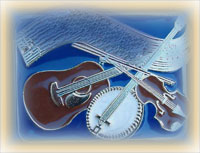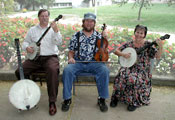The Old 78's and Shitakes: - Carol Anne Rose & Curly Miller - page 3

By Steve Green (Page 3)
Curly’s Fiddling
Around 1997, Curly and Carole Anne started listening to tunes from the South Central United States. One evening, while Carole Anne was cooking dinner, Curly was working on the tune, “Possum on the Rail,” from the Mississippi Possum Hunters. He exclaimed to Carole Anne, “If I add any of my usual bowing habits to this tune, it just doesn’t work!” This was the genesis of Curly’s “If it doesn’t need to be there, don’t put it there!” philosophy of bowing. This approach to bowing became an essential part of many of the duo’s signature tunes, fiddle rags from the Mississippi, Arkansas, and East Texas region. Curly listened intently for years to reissues of the East Texas Serenaders, Smith’s Garage Band, Narmour & Smith, the Stripling Brothers, Hoyt Ming, and the Roane County Ramblers. His effort has been to reproduce the tones that he hears, including the hillbilly implementation of vibrato that Carole Anne refers to as “the wobble.” Many of these tunes are in the keys of C, F, B-flat, and E-flat, which in and of themselves add a richness of character to the music. This is especially true when Curly plays their repertoire of flatted-key waltzes by the East Texas Serenaders, like “Dream Shadows” and “The Adeline Waltz,” both in E-flat.
People often remark on the touch, texture, and volume of Curly’s fiddle playing without realizing how much effort goes into producing such a large, driving sound. His instrument, a French violin, is not in itself a particularly loud fiddle. Although he could get the same volume he has now with less effort from a louder instrument, it would lose some of its subtleties. When you hear Curly’s fiddling, you don’t just hear room-filling volume, you hear powerful, artful, texture. Never is this more demanding of a fiddler than when playing the signature flatted-key tunes of the Old 78s, in which, Curly says, “I work for the texture in every note.” To add to this fiddle sound, Carole Anne’s banjo and style of playing creates a unique, dark rhythm strongly reminiscent of the cadence and spirit of the old recordings. Jointly, their playing emphasizes the one and three down beats with strong phrasing that includes empty space to let the pure sound of each instrument shine through. This is the unique combination that gives this duo a sound that folks often say in “very different.” Curly and Carole Anne heard people exclaim, “They sound just like the old 78s!” so many times that it stuck as a band name.
The Duo: Off the Farm
Frequent bookings at the Ozark Folk Center at Mountain View, Arkansas introduced Curly and Carole Anne to callers and performers from around the country and have led to their travels of recent years. They have played in concert with many of the greats of old-time music at the Folk Center, including Tom, Brad, & Alice, Mike Seeger, Art Stamper, Ginny Hawker and Tracy Schwarz, and Mitch Reed, to name a few, and have taught banjo and fiddle workshops alongside many of them as well. This resulted in an East Coast dance tour in 2002 with Beth Molaro, an invitation to teach and play for dances at the Swannannoa Gathering Old-Time Week 2004, and the following year to teach and play for dances at Ashokan Southern Week. These were dream gigs for the duo who once thought that they might never be able to leave their farm for more than a few days at a time. In the early 1990s they had met caller Peter Lippincott, whose work with his wife Marget initiated the St. Louis Childgrove Country Dancers. Peter, also the composer of “Snake River Reel,” has played guitar with the duo for the Fayetteville monthly contra dance since 1993. Curly and Carole Anne have toured with Peter, who calls contra dances and the Missouri squares that he collected many years ago. The trio has an April 2007, dance tour scheduled for Philadelphia, Maryland, and Washington, DC.
Classic and Minstrel Banjo – Then and Now
Since their introduction to classic and minstrel banjo through Clarke Bueling, Curly and Carole Anne have actively pursued the style, which originated in the 1880s. The American Banjo Fraternity, which currently preserves and promotes the music, recordings, ideas, and history of the style, composers and players, and was also a great resource for their research. Their first CD, Camp Meeting, produced in 1993, was also the debut of their classic banjo pieces. Curly arranged the second banjo parts for Carole Anne and the bowed bass parts for himself. In 2003, Carole Anne decided to pursue her interest in minstrel banjo and started taking lessons from Clarke. Some time after, the three musicians came to the realization that here in Northwest Arkansas was the possibility of a collaboration of classic and minstrel banjo, old-time, and other early banjo styles. As Clarke put it, “We should do it if only to show that we can share!”
Curly and Clarke play solos of their choice, and they also double up on the tunes that they have in common. Carole Anne plays the seconds in three-finger classic banjo style or uses her clawhammer back-up technique on the six-string banjo. Curly and Clarke take turns playing the cello banjo (a rare Stewart five-string with a 16” pot and a skin head) in some of the arrangements. Curly’s ragtime fiddle band tunes hit Clarke right where he lives and, of course, they mix in some of their hillbilly and ethnic tunes. For these, Clarke plays either the cello banjo or three-finger style on a five-string banjo to add to Carole Anne’s relentless clawhammer backup. Clarke also plays his minstrel banjo and sings old songs to a variety of arranged parts. They are in the initial phases of recording a CD together as the Old 78s [now available] and will be performing on the Old-Time Stage at Merlefest 2007, in addition to playing a dance of two for caller Peter Lippincott.
Looking Ahead
Curly and Carole Anne are quick to acknowledge the influence of the many musicians, living and gone, who have influenced their unique style. As they look ahead toward the next years of farming, touring, playing dances, meeting the folks in the larger old-time community, and the never-ending research into old-time music styles, we can be sure that their music will continue to reflect the farm life that shapes who they are.
These recordings are available from Curly and Carole Anne’s website:
http://www.theold78s.com/
Old Time fiddle Rags, Classical and Minstrel Banjo (with Clarke Buehing)
Camp Meeting – Classic Banjo & Old Fiddle Tunes
I Love This Girl – Old Time Fiddle & Banjo
Horse Shoe Bend – Old Fiddle Tunes – Fiddle Banjo & Bowed Bass


Steve Green, author of this article, lives near Fayetteville, Arkansas, where he builds individually custom-engineered wheelchairs. Evenings and weekends he can be found calling dances or working on an off-grid cabin not far from Mountain View, Arkansas.
“Old 78’s and Shiitakes: Carole Anne Rose and Curly Miller”by Steve Green was reprinted, with permission, from The Old-Time Herald, a magazine dedicated to old-time music.
More Articles on the The Old 78's |
The Old 78's Recordings |
The Old 78's Videos |
| “Old 78’s and The Cello Banjo
By Paul Roberts |
All the music on The Old 78’s: Old Time Fiddle Rags, Classic and Minstrel Banjo can be previewed at http://cdbaby.com/cd/old78s and purchased there or from The Old 78’s website http://www.theold78s.com |
Jim Nelson, reviewer for THE OLD TIME HERALD, writes:
"From start to finish, this has to be one of the more enjoyable, and unusual selections of dance fiddle music released in quite some time....I suspect that if this duo could be somehow transported back through time about 150 years and plopped down smack dab in the middle of a dance in their neck of the woods, no one would even bat an eye.
 The Old 78's , Classic banjo orchestra music, ragtime and minstrel banjo tunes
The Old 78's , Classic banjo orchestra music, ragtime and minstrel banjo tunesFrom Kingston, Arkansas
Visit their website at http://www.theold78s.com
Home | Products | Prices | Banjos | About Us | Blog
All Articles | Policy | Contact Us | Directory
Copyright (c) 2008-2013 BanjoCrazy.com. All rights reserved. 970-731-3117
